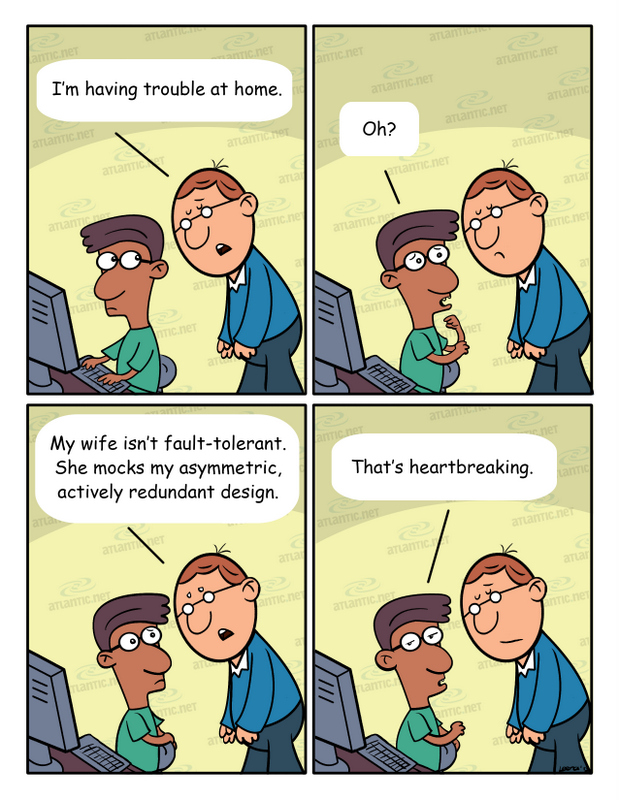A Broad View of Redundancy
July 26, 2013 by Eddie ( 5 ) under Disaster Recovery
0 Comments
No one wants to be redundant in conversation, but everyone wants a redundant network. Redundancy allows your system to keep operating smoothly even if something goes wrong. By creating additional instances – through active-active or active-passive networking mechanisms – you can make your network more solid and less prone to being knocked offline due to failure. Redundancy of HLR, case: two HLRs, both are active. Every HLR uses half capacity for its own data and a half for backup of the second HLR.
In a nutshell, an active-active solution runs two different instances simultaneously that are identical. It’s called active-active, as you can imagine, because both parts of the network involved are engaged. Active-passive solutions, on the other hand, involve one piece of the network that’s running. At the same time, another one waits to jump in if there is a problem (similar to second-string players on a sports team, with the advantage that the backup components are just as strong as the active ones).
Redundancy technology essentially enables greater reliability of the network. You may be familiar with the concept of “high-availability.” A highly available network is accessible at almost every moment. By their nature, failures are unexpected, so building the possibility for failures into your network – protections that account for their possibility – can give your network and site high availability.
The uptime of the site, then, is directly related to the network’s redundancies. Typically hosting companies will guarantee 99.9% or higher uptime. A quality hosting service can make this promise because it is completely confident the redundancies are in place to keep its customers running almost all of the time. In our case, though, we guarantee 100% uptime because we consider any moment of downtime unacceptable.
Finally, we will look at several preliminary steps you can take when considering networking redundancy from Robert J. Shimonski of WindowsNetworking.com. His concepts are common to all networking environments, i.e., applicable to those using both Windows and Linux servers.
Redundancy: An Insurance Policy
Mike Hughes views redundancy as essentially an insurance policy for any engineering company that wants to make sure its systems remain active at all times. Essentially, for engineering firms, redundancy is a question of investment: “weighing risk versus value,” according to Mike. In other words, is it worth the cost it takes to implement the redundancies, or is it better to save the money and risk something going wrong?
You can see how redundancy applies broadly to every company. No company wants to lose productivity and frustrate customers or users. In a hosting environment, this technology is critical because websites are the virtual face of a company. If the site goes down for any reason, it looks like the owner has closed up shop, which can be devastating for business.
Redundancy: Mission Critical
FileBound looks at redundancy as the basis for business continuity concerning document accessibility. When multiple users must have the ability to view and analyze documents from several different locations, the redundancies of the underlying system allow that access to be failproof: any failures become irrelevant because the system is designed to automatically reroute the network as needed.
In the case of document storage, redundancy involves multiple instances of documents in a variety of locations. FileBound offers a checklist to ensure that redundancies shift into place immediately so that no data is lost and no users are left in the cold. In hosting, companies offering high uptime rates have confidence in the redundancies of their systems so that whatever is being stored or presented online is always available and populating correctly.
Redundancy: Preliminary Networking Strategies
Here are several pieces of advice from Robert J. Shimonski specific to the redundancy of a network:
- Action plan – He recommends looking at your network’s infrastructure as it is now and using that information to develop a concrete plan to enable redundancy, complete with steps to deploy and test any new components to ensure they account for failures.
- Testing – Specifically, Robert views testing as the “key to your success.” Setting up automated recovery mechanisms in the event of failure is not enough. If the backup system does not take over immediately, the redundant system is not worth much. Whether a redundant network is automated or manual, you need alternate plans of action should redundancies not work: “redundancy-redundancies,” in a sense.
- Analysis – Beyond testing, Robert underscores the need to conduct a risk analysis assessment. He also emphasizes the need to focus heavily on the core site where most of your resources are in place. When you start thinking about specific redundancy scenarios, the primary tools you will want to consider are load-balancing, failover protocols, and clustering. That last concept is widely used to bring together multiple system components into a single unit, an industry-standard way to mitigate risk.
Conclusion
As you can see, redundancy is a concept that has been adopted in every field with a heavy technological basis. When a cloud hosting service has tested its systems extensively and knows its redundancies will appropriately back up the core components as needed, it can advertise high uptime without the fear that systems will ever go down.
At Atlantic Hosting, we are confident enough in our redundancies to offer 100% uptime in the Service Level Agreement (SLA) with all our managed cloud hosting and public hosting. We also offer HIPAA compliant hosting solutions with HIPAA disaster recovery services. Contact us today for a consultation.
by Kent Roberts
Get a $250 Credit and Access to Our Free Tier!
Free Tier includes:
G3.2GB Cloud VPS a Free to Use for One Year
50 GB of Block Storage Free to Use for One Year
50 GB of Snapshots Free to Use for One Year

